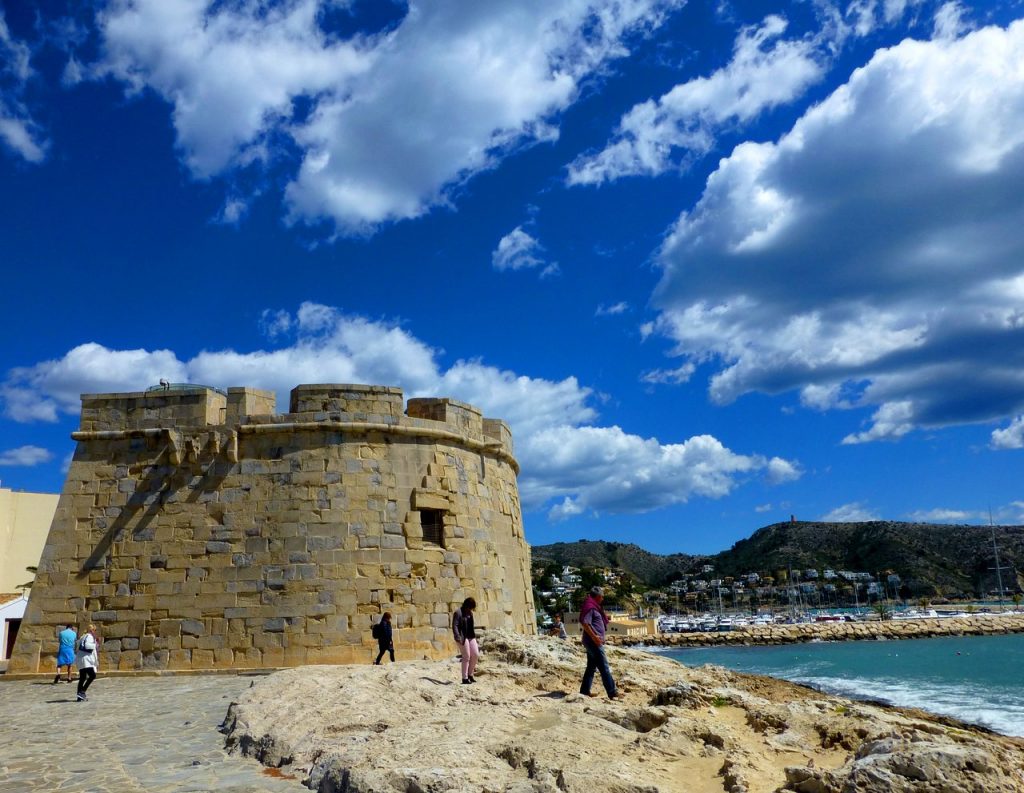Nestled on the picturesque coast of the Mediterranean, in the charming town of Moraira, Spain, stands the Castillo de Moraira. This fortress, a silent witness to centuries of history, encapsulates the struggles, architectural prowess, and cultural shifts that have swept across this part of Spain over the ages. Its strategic location, overlooking the azure waters of the Mediterranean, has made it a coveted possession for various powers throughout history. Today, it stands not only as a monument to the past but also as a beacon attracting tourists from around the world, eager to delve into its storied history and enjoy the stunning views it offers.
Historical Background
The Castillo de Moraira was constructed in the 18th century, during a time when the Spanish coast was frequently harassed by pirate attacks. These pirates, primarily from North Africa, posed a significant threat to the coastal towns, plundering and attacking the local population. The castle was built as a defensive measure to protect Moraira and its inhabitants from these raids. Its design and construction were indicative of the military architecture of the time, with a focus on functionality and defense.
The castle is built in a unique shape, resembling a pebble. This design was not merely aesthetic but served a strategic defensive purpose. The rounded walls were intended to deflect cannonballs, a common threat from the sea-faring attackers. This architectural feature highlights the ingenuity and thoughtfulness that went into the castle's construction, making it a formidable fortress against the pirate menace.
Architectural Features
The Castillo de Moraira is an exemplary model of 18th-century military architecture. Its robust walls, made of locally sourced stone, have withstood the test of time and elements. The fortress was designed with a single entrance, which could be easily defended in the event of an attack. Inside, the castle was spartan, with the primary focus on military functionality. There were provisions for soldiers' barracks, ammunition storage, and lookout points, all designed to ensure the castle could withstand a siege if necessary.
One of the most notable features of the Castillo de Moraira is its location. Perched on a rocky outcrop, it offers panoramic views of the Mediterranean Sea and the surrounding coastline. This vantage point was crucial for early detection of incoming threats, allowing the defenders to prepare and repel attacks effectively. Today, this same location offers visitors breathtaking views, making it a popular spot for photography and sightseeing.
Historical Significance
The Castillo de Moraira is more than just an architectural marvel; it's a testament to the turbulent history of the Spanish Mediterranean coast. Its very existence speaks to the era of piracy and the constant threat faced by coastal communities. The castle played a crucial role in safeguarding the town of Moraira and its inhabitants, enabling them to lead their lives with a semblance of security in an otherwise perilous time.
Moreover, the castle's history reflects the broader geopolitical dynamics of the Mediterranean region. It serves as a reminder of the strategic importance of this area, contested by various powers throughout history. The fortifications and battles that occurred here are part of the larger narrative of Spain's maritime history and its interactions with the wider Mediterranean world.
The Castillo Today
In the present day, the Castillo de Moraira has transitioned from a military fortress to a cultural and historical landmark. It has been meticulously preserved, allowing visitors to step back in time and experience a piece of 18th-century Spain. The castle is open to the public, offering guided tours that delve into its history, architecture, and the broader historical context of the region.
The Castillo de Moraira is not just a draw for history buffs. Its picturesque setting makes it a popular destination for tourists of all kinds. The views from the castle are unparalleled, offering a stunning panorama of the Mediterranean Sea and the charming town of Moraira. It's a perfect spot for a leisurely visit, where one can appreciate both the beauty of Spanish architecture and the natural splendor of the coast.
Cultural Impact and Legacy
The enduring legacy of the Castillo de Moraira extends beyond its historical and architectural significance. It stands as a symbol of the resilience and ingenuity of the people of this region. The castle has become an integral part of the identity of Moraira, contributing to the town's cultural heritage and its appeal as a tourist destination.
Moreover, the castle's preservation and continued relevance are a testament to the importance of protecting historical landmarks. It serves as an educational resource, offering insights into the past and inspiring appreciation for history and architecture. The Castillo de Moraira is a prime example of how historical sites can be preserved and integrated into the cultural fabric of a community, enriching the present and future generations.
The Role of Castillo de Moraira in Modern Times
In modern times, the Castillo de Moraira has transcended its original defensive purpose to become a focal point of cultural identity and pride for the local community. It is a venue for various cultural events and activities, including art exhibitions, historical reenactments, and community gatherings. These events not only breathe life into the ancient walls but also foster a sense of community and continuity among the residents of Moraira.
Conservation Efforts
The preservation of Castillo de Moraira is a testament to the value placed on cultural heritage and historical architecture. Conservation efforts ensure that the structure remains intact, allowing future generations to witness and learn from the past. These efforts are a collaboration between local authorities, cultural heritage organizations, and the community, underscoring the collective responsibility to safeguard our historical legacy.
Educational Impact
The educational impact of Castillo de Moraira is profound. It serves as an outdoor classroom for students and history buffs, offering a tangible connection to the topics of military architecture, European history, and maritime defense strategies. Through guided tours and informational placards, visitors gain insights into the life of the 18th century, the technological advancements of the time, and the social dynamics of coastal defense communities.
Tourist Attraction
As a tourist attraction, Castillo de Moraira contributes significantly to the local economy, drawing visitors from across the globe to this picturesque part of Spain. Its allure lies not only in its historical significance but also in its stunning location. Visitors are treated to majestic views of the Mediterranean, making it a perfect blend of educational journey and scenic retreat. The castle's charm adds to Moraira's appeal as a destination that offers both cultural depth and natural beauty
Frequently Asked Questions (FAQs)
What is the historical significance of Castillo de Moraira?
Castillo de Moraira was built in the 18th century to protect the Spanish coast from pirate attacks, serving as a vital defense mechanism for the town of Moraira and its inhabitants against North African pirates
Can visitors tour Castillo de Moraira?
Yes, Castillo de Moraira is open to the public, offering guided tours that explore its history, architecture, and the broader historical context of the Mediterranean region
What architectural features make Castillo de Moraira unique?
The castle is known for its pebble-shaped design intended to deflect cannonballs, robust walls made of locally sourced stone, and a strategic location that offers panoramic views of the Mediterranean Sea
How has Castillo de Moraira impacted the local community?
Beyond its historical and architectural significance, Castillo de Moraira has become a symbol of resilience and ingenuity, contributing significantly to the town's cultural heritage and tourism appeal
Why is Castillo de Moraira considered an important historical site?
It encapsulates the struggles, architectural prowess, and cultural shifts of the Spanish Mediterranean coast, offering insights into the era of piracy and the strategic importance of this region throughout history





